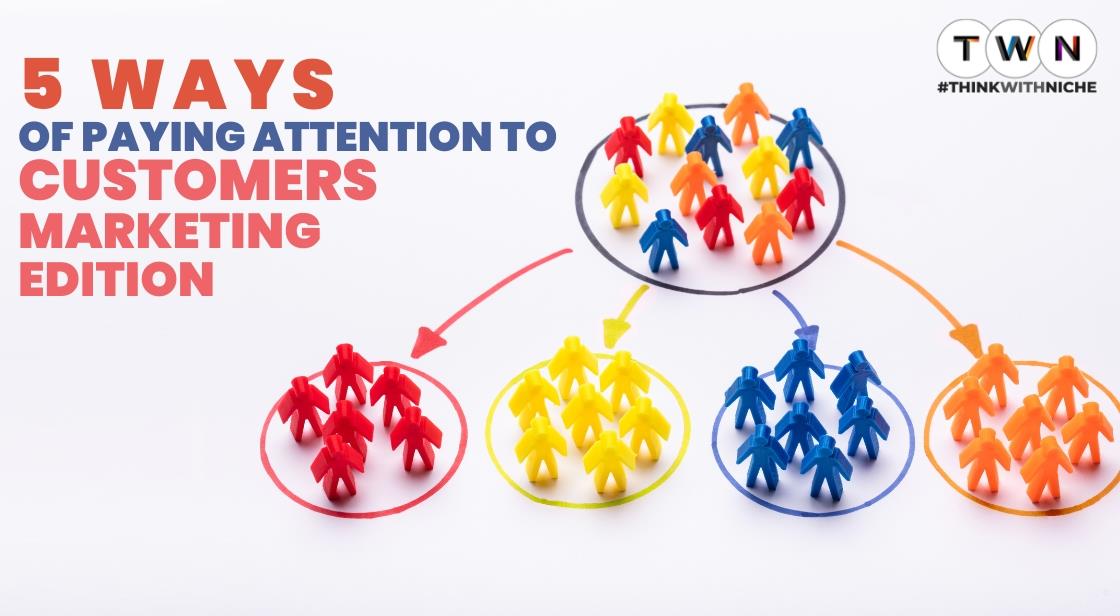5 Ways of Paying Attention to Customers Marketing Edition

Blog Post
In today's competitive business landscape, understanding and effectively engaging customers is crucial for sustainable success. Customers Marketing encompasses key strategies such as personalization, customer segmentation, CRM, customer experience, retention, and loyalty.
By tailoring marketing efforts to individual preferences, businesses can deliver relevant experiences that resonate with customers. Through segmentation, businesses can target specific customer groups with tailored messages and offers.
CRM enables the management of customer relationships and provides insights to deliver personalized support.
Customer experience focuses on creating exceptional interactions at every touchpoint, fostering loyalty and advocacy. Retention and loyalty strategies aim to keep customers engaged, satisfied, and coming back for more.
By leveraging these key aspects of Customers Marketing, businesses can build lasting relationships, drive growth, and stand out in the market.
In the ever-evolving world of marketing, businesses must constantly adapt to effectively engage with customers. By implementing the right strategies, businesses can create meaningful connections, drive customer loyalty, and ultimately achieve their marketing goals.
In this article, we will explore the top five strategies to engage with customers in marketing, helping businesses thrive in today's competitive landscape.
In today's highly competitive business landscape, paying attention to customers has become more crucial than ever. With empowered consumers demanding personalized experiences and meaningful interactions, businesses must prioritize customer engagement to stay relevant and successful. Effective customer-centric marketing strategies can not only foster brand loyalty but also drive revenue growth.
In this article, we will explore five proven ways to pay attention to customers in marketing, backed by the latest data and facts. By implementing these strategies, you can enhance customer satisfaction and build lasting relationships with your target audience.
What is Customers Marketing?
Customers Marketing refers to the strategic and operational activities that businesses undertake to understand, attract, engage, and retain customers. It involves the application of marketing principles and techniques specifically focused on catering to the needs, preferences, and behaviors of customers.
Customers Marketing encompasses various strategies and tactics aimed at building strong customer relationships, enhancing customer satisfaction, and driving customer loyalty. It involves analyzing customer data, conducting market research, segmenting target audiences, and developing tailored marketing campaigns to effectively communicate and deliver value to customers.
The primary goal of Customers Marketing is to create meaningful and personalized experiences for customers throughout their journey with a brand. It involves understanding customer motivations, desires, and pain points to develop targeted messaging, products, and services that resonate with the intended audience.
Key aspects of Customers Marketing:
1. Personalization:
Personalization involves tailoring marketing efforts to individual customer preferences and behaviors to deliver relevant and customized experiences. It requires collecting and analyzing customer data to understand their preferences, demographics, purchase history, and browsing patterns. With this information, businesses can create personalized marketing messages, product recommendations, and offers that resonate with individual customers.
Personalization can be achieved through techniques such as targeted email marketing, dynamic website content, personalized product recommendations, and customized advertisements. By providing a personalized experience, businesses can enhance customer engagement, satisfaction, and loyalty.
2. Customer Segmentation:
Customer segmentation involves dividing the target market into distinct groups based on common characteristics such as demographics, psychographics, purchasing behavior, or preferences. This enables businesses to better understand their customers and tailor their marketing strategies to each segment's specific needs and preferences.
By segmenting customers, businesses can develop targeted messaging, create relevant offers, and allocate resources effectively. Segmentation can be based on factors like age, gender, location, interests, lifestyle, or purchasing habits.
By focusing on specific customer segments, businesses can optimize their marketing efforts and increase the likelihood of resonating with their intended audience.
3. Customer Relationship Management (CRM):
Customer Relationship Management (CRM) is the process of utilizing customer data and technology to manage and nurture customer relationships effectively. CRM systems help businesses track customer interactions, collect and analyze data, and automate various marketing processes.
CRM enables businesses to understand each customer's history, preferences, and needs, allowing for personalized communication and targeted marketing campaigns. CRM systems facilitate tasks such as managing customer contacts, tracking customer interactions, monitoring sales pipelines, and providing personalized support.
By implementing CRM practices, businesses can enhance customer satisfaction, improve customer retention rates, and drive revenue growth.
4. Customer Experience (CX):
Customer Experience (CX) refers to the overall perception and interaction a customer has with a brand throughout their entire journey, from initial awareness to post-purchase interactions. It encompasses every touchpoint and interaction between the customer and the brand, including online and offline experiences, customer service, product quality, and more.
A positive customer experience is crucial for building customer loyalty, advocacy, and long-term relationships.
To optimize the customer experience, businesses need to understand and meet customer expectations at every stage of the customer journey. This requires seamless integration and consistency across all channels, including websites, social media, physical stores, mobile apps, and customer support. Providing a memorable and positive experience involves:
a) Usability and Convenience: Making it easy for customers to navigate and interact with your brand. This includes user-friendly websites, intuitive interfaces, streamlined checkout processes, and responsive customer support.
b) Personalization and Customization: Tailoring experiences to individual customer preferences and needs. This can involve personalized product recommendations, customized communications, and personalized customer service.
c) Consistency: Maintaining consistency across all touchpoints to create a cohesive brand experience. This includes aligning messaging, branding, and values across different channels and departments.
d) Proactive Communication: Keeping customers informed and engaged throughout the customer journey. This includes providing timely updates on order status, addressing customer inquiries promptly, and proactively seeking feedback.
e) Resolving Issues and Providing Support: Offering efficient and empathetic customer support to address customer concerns or issues promptly. This includes providing multiple channels for support, such as phone, email, live chat, or social media.
By focusing on delivering exceptional customer experiences, businesses can differentiate themselves from competitors, build trust, and foster long-term customer loyalty.
5. Customer Retention and Loyalty:
Customer retention and loyalty are critical for business success. It is more cost-effective to retain existing customers than to acquire new ones, and loyal customers tend to spend more, refer others, and have a higher lifetime value. To foster customer retention and loyalty, businesses can implement strategies such as:
a) Customer Satisfaction: Ensuring customers are satisfied with their purchase and overall experience. This can be achieved through quality products, excellent customer service, and addressing customer feedback and concerns.
b) Rewards and Incentives: Implementing loyalty programs, offering exclusive discounts, or providing rewards for repeat purchases to encourage customer loyalty and repeat business.
c) Personalized Engagement: Engaging customers on a personal level by sending personalized offers, birthday discounts, or personalized messages to make them feel valued and appreciated.
d) Customer Feedback and Surveys: Seeking customer feedback and opinions to understand their needs and preferences better. This information can be used to improve products, services, and overall customer experience.
e) Continuous Communication: Staying connected with customers through email newsletters, social media updates, or personalized follow-ups to maintain a relationship and provide ongoing value.
By focusing on customer retention and loyalty, businesses can build a strong customer base, drive repeat sales, and benefit from positive word-of-mouth referrals.
Customers Marketing is a customer-centric approach that recognizes the importance of understanding and meeting customer needs to drive business growth and success. It requires businesses to continually listen to customer feedback, adapt to changing customer preferences, and invest in building long-term customer relationships.
Discover five effective strategies for paying attention to customers marketing. Personalization, customer feedback, engaging content, social media listening, and community-building are key to enhancing customer satisfaction and loyalty. Stay informed with the latest data and facts to optimize your customer-centric approach.
Also Read: Strategies of entrepreneurship development
5 Ways of Paying Attention to Customers Marketing Edition
1. Embrace Personalization for Tailored Experiences
Leveraging Data to Understand Customer Preferences and Behavior
In the era of data-driven marketing, leveraging customer data is essential for creating personalized experiences. By analyzing customer behavior, preferences, and purchase history, businesses can gain valuable insights to tailor their marketing efforts.
Personalization can take various forms, including personalized product recommendations, customized email campaigns, and targeted advertising. According to a recent study, 80% of consumers are more likely to make a purchase from brands that provide personalized experiences.
Implementing robust customer relationship management (CRM) systems and advanced analytics tools can help you effectively collect and utilize customer data for personalized marketing strategies.
2. Prioritize Customer Feedback and Surveys
Listening to Customer Voices for Continuous Improvement
To truly understand your customers' needs and preferences, actively seeking their feedback is paramount. Conducting customer surveys, both online and offline, allows you to gather valuable insights and measure customer satisfaction levels.
Pay attention to feedback channels such as social media platforms, review websites, and customer support interactions. Analyzing feedback trends and addressing customer concerns promptly demonstrates your commitment to their satisfaction.
A recent survey found that 93% of customers are more likely to make repeat purchases from companies that provide excellent customer service. By implementing a customer feedback loop and making necessary improvements, you can foster stronger customer relationships and build brand advocacy.
3. Create Engaging Content Across Channels
Captivating Audiences with Compelling Storytelling
Engaging content is a powerful tool for capturing and retaining customers' attention. Develop a content marketing strategy that aligns with your target audience's interests and preferences. Focus on creating valuable, informative, and entertaining content that resonates with your customers.
Incorporate storytelling techniques to connect with your audience on an emotional level. Utilize a variety of content formats, including blog articles, videos, infographics, and podcasts, to cater to diverse customer preferences.
According to recent research, 78% of consumers believe that organizations providing custom content are more trustworthy. By consistently delivering high-quality content across channels, you can establish thought leadership and deepen customer engagement.
4. Harness the Power of Social Media Listening
Proactive Monitoring of Customer Conversations
Social media has become a significant platform for customer engagement, brand advocacy, and reputation management. Actively monitor social media channels to listen and respond to customer conversations. Pay attention to both direct mentions of your brand and relevant industry discussions.
By promptly addressing customer inquiries, complaints, or feedback, you can demonstrate your commitment to customer satisfaction. Additionally, social media listening provides invaluable insights into consumer sentiment, emerging trends, and competitor analysis.
According to recent statistics, 71% of consumers who experience positive social media interactions with a brand are likely to recommend it to others. Effectively harnessing social media listening can help you gain a competitive edge and build stronger relationships with your target audience.
Utilize social media listening tools to track keywords, hashtags, and mentions related to your brand. Analyze customer sentiment, identify recurring themes, and leverage the insights to refine your marketing strategies. Engage with customers in real-time, addressing their concerns, and showcasing your commitment to providing exceptional experiences.
By actively participating in conversations and leveraging social media as a customer service channel, you can nurture positive brand perception and foster customer loyalty.
5. Build Communities and Foster Customer Engagement
Creating Spaces for Customer Interaction and Collaboration
Creating communities around your brand can significantly enhance customer engagement and foster a sense of belonging. Establish online forums, social media groups, or dedicated platforms where customers can connect with each other and share experiences.
Encourage customer-generated content, such as user-generated reviews, testimonials, and stories. Actively participate in these communities, facilitating discussions and providing valuable insights.
By building a community-driven ecosystem, you not only strengthen customer relationships but also benefit from organic advocacy and word-of-mouth marketing. Recent studies indicate that 77% of customers are more likely to purchase from brands with active customer communities.
Conclusion:
In today's customer-centric era, paying attention to customers is paramount for business success. By implementing these five strategies, you can enhance customer engagement, satisfaction, and loyalty. Embrace personalization to deliver tailored experiences based on customer preferences and behaviors.
Prioritize customer feedback to continuously improve your products and services. Create engaging content that captivates audiences and fosters emotional connections.
Harness the power of social media listening to proactively monitor and respond to customer conversations. Lastly, build communities to foster customer engagement and facilitate collaboration.
By incorporating these strategies into your marketing efforts, you can create a customer-centric approach that not only meets but exceeds customer expectations. Remember, paying attention to customers is an ongoing process that requires continuous adaptation and improvement.
Stay informed about the latest trends, technologies, and customer preferences to stay ahead in the ever-evolving marketplace. By prioritizing customer attention, you can build long-lasting relationships, drive customer loyalty, and fuel the growth of your business.
You May Like
EDITOR’S CHOICE












